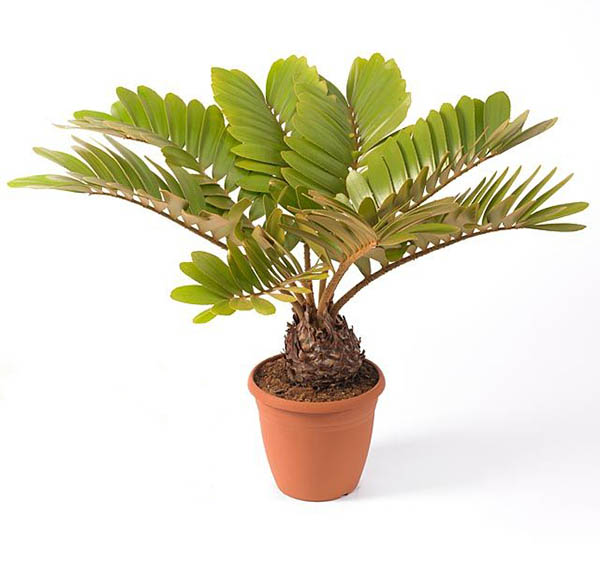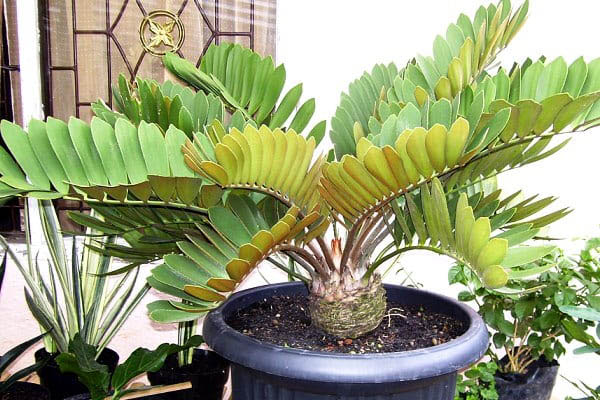Zamia (Cardboard Palm)
Zamia belongs to the Zamiaceae family, which is part of the Cycad division, the most ancient representatives of our planet's flora. These plants are widespread in subtropical and tropical regions of America, with approximately 60 known species of Zamia. They are evergreen, small plants with a short barrel-shaped trunk and beautiful feathery leaves.
Cardboard Palm naturally inhabits warm and humid tropical forests. Nevertheless, many species adapt easily and thrive well indoors. All types of Zamia are highly decorative, have a long lifespan, and form lush crowns of foliage, making them popular in gardens and parks in subtropical regions. They resemble short palms with thick trunks and dense clusters of feathery leaves.

The height of zamia in home conditions is approximately 50-70 cm. The foliage is glossy and leathery. The leaflets are round, either entire or serrated. Leaf stalks are smooth, sometimes covered with a few spines.

Zamia is dioecious, with distinct male and female specimens. Female zamias have a reddish seed cone with red seeds in the center of the rosette. Male cones are oval and smaller.
The barrel-shaped trunk of Cardboard Palm serves to retain moisture during droughts, and in young plants, it resembles a tuber usually underground. While the trunk is underground, zamia shoots grow slowly, but once it emerges, their growth accelerates.
Many people mistakenly consider zamia and
Popular Types of Cardboard Palm (Zamia)
- Zamia furfuraceae – the most popular in indoor cultivation. It has a barrel-shaped trunk slightly raised from the ground. The leaves are grayish-green, reaching 1-1.5 meters in nature, but significantly smaller indoors. They are elongated, dense, and leathery, with clearly defined parallel veins on the lower side.
- Zamia pseudoparasitica – can grow up to 3 meters. Adult zamia leaves are toothed and linear, reaching a couple of meters in length, held on stalks with sparse spines. The average leaf length is 35-40 cm, and the width is 3-5 cm. The lower side has prominent longitudinal veins.
- Zamia latifolia – a low-growing evergreen with a thick club-shaped underground or above-ground trunk. The leaves at the top, 2, 3, or 4 in number, can grow up to 0.5-1 meter. They are elongated oval.
- Zamia pygmaea – a dwarf evergreen plant with a small underground trunk, a couple of centimeters thick and 23-25 cm long. The leaves reach a length of 25-45 cm.


Care for Cardboard Palm (Zamia) at Home
Lighting: Cardboard Palm prefers bright light and can tolerate direct sunlight, unlike the shade-tolerant ZZ Plant. If zamia has been deprived of bright light in winter, it's better not to expose it to direct sunlight immediately; instead, gradually acclimate it to high light. To ensure even leaf growth, rotate the pot periodically to expose different sides to light.
Temperature: As a tropical plant, zamia prefers a comfortable temperature of 65-75°F/18-24°C . In winter, when its growth slows down, reduce the temperature to 57-62°F/14-17°C. Protect it from cold drafts.
Air Humidity: Zamias are not demanding regarding indoor air humidity. Spraying is only necessary to remove dust from the leaves.
Watering: During the spring and summer, zamia is in a growth phase, requiring thorough watering. However, water only after the topsoil has dried. Reduce watering in the fall and water sparingly in winter. Avoid overwatering, as zamia can tolerate drying out.
Fertilization: During the spring and summer seasons, fertilize Cardboard Palm monthly. Avoid fertilizing in winter.
Soil: An optimal soil mix includes equal parts of leafy and loamy soil, compost, peat, and sand. Adding crushed brick can enhance soil looseness.
Transplanting: Zamias are transplanted infrequently as they grow very slowly. Use a slightly larger pot for transplanting.
Propagation of Zamia: In home conditions, zamia can be propagated from seeds by sowing them in a light substrate, covering them with glass to maintain necessary humidity. However, seed propagation is a complex process due to the plant's slow development. It is much easier to propagate zamia using stem cuttings. Place the cutting in water to root and then transplant it into prepared soil.
Diseases and Pests: Zamias can be affected by scale insects, which can be eliminated with insecticides.
Remember to take precautions when handling any plant material, including zamia, as some plants may cause skin irritation or other allergic reactions.




